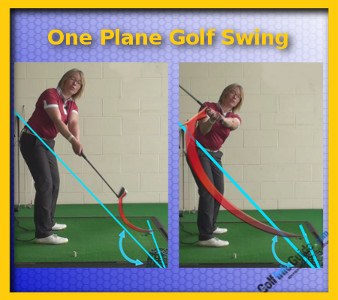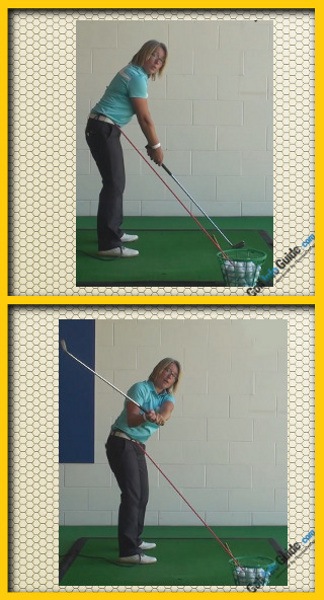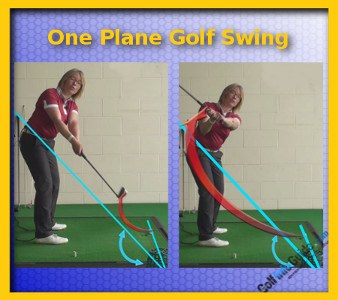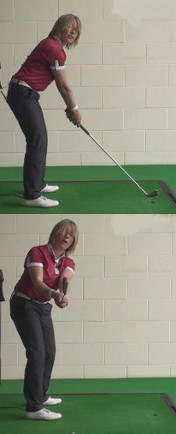
Any time you watch or listen to people talking about golf swings, partic ularly on the PGA tour, you will hear a lot about the plane of the swing and whether somebody is a one plane or two plane swinger of the club.
As you would expect, one plane is the description given to a club that rises on the backswing and falls on the downswing on exactly the same plane, and a two plane swing is a swing that raises on a plane line and moves off the plane line to a slightly higher plane, before dropping back to the first plane before impact with the golf ball.
The characteristics of a one plane swing are you often see a golfer with a more inclined spine angle at set up and lower hand position. This results in a steeper shoulder incline during the backswing turn and a left forearm that is flatter at the top of the swing, and is laid across the shoulder plane at the top of the backswing. The chest, shoulders and arms also turn very much in a connected fashion, and less weight is transferred to the rear leg during the backswing phase.

A two plane swing is often seen as a more conventional action. The set up posture can be taller and the backswing may be slightly flatter initially, with a rising phase during the top of the backswing, when the left arm will rise above the shoulder plane into a steep action. Dropping of the right elbow in the downswing should flatten the plane back to the original plane line halfway down the downswing before impact. More lateral weight transfer is also used in a two plane golf swing.
If you're considering whether you should try a one plane or two plane movement, it may be worth seeking out a local PGA golf professional to video your swing and discuss the basic options with you before you embark on changing your current action.

Main Differences Between One Plane Swing and Two Plane Swing
If you spend any amount of time watching golf or talking to golfers, you have probably heard discussions on the merits of one plane and two plane swings. All golf swings can be placed into one of these two categories, and while one is not necessarily better than the other, they do have their pros and cons. Golfers who are serious about long-term improvement need to make a conscious decision with regard to which style of swing they are going to pursue. Once you decide if you are going to use a one plane or two plane swing, you can then customize your mechanics to make your decision.
Before we get too far into this discussion, it is important to emphasize that each of these swing types can be used to play good golf. There are players on the PGA Tour who fall into each of these two categories, which is a sure sign that high-quality golf is possible either way. The point here is not to decide on which of these two is the best option, as they can both lead you to quality results. Rather, the point is to figure out which is the better path for your own game. Rather than continuing to practice without any specific direction in mind, settle on a one or two plane swing and work hard to refine the techniques that go into producing such a motion.
In this article, we will attempt to provide you with all of the information necessary to make an informed decision on this point. We are not going to make the decision for you, of course, because only you can decide which path is best for your purposes. Once you have a clear picture of what each of these swing types represents, and what strengths and weaknesses come along with them, this choice will be surprisingly easy. Also, your current swing is going to fall into one of these two categories, you will have to decide whether or not you would like to switch directions with the hopes of finding a brighter future on the fairways.
Once you have made your choice on this point, it might be a smart move to work with a teaching professional in order to make your progress as speedy as possible. It can be hard to monitor all of the various mechanics of your swing all on your own, so working with a teacher can be a great help. Even if you only take one lesson a month at your local course, the direction of an experienced pro can help to keep you on track. Speak with your pro regarding your thoughts on a one plane vs. two plane swing and he or she will make sure you continue to move in the right direction.
All of the content below has been written from the perspective of a right-handed golfer. If you happen to play left-handed, please take a moment to reverse the directions as necessary.

The Basic Idea
It is important for you to understand what these terms mean before we move any further into a discussion of their differences and their pros and cons. You need to be able to know a one plane swing when you see one, and likewise, you need to know what a two plane swing looks like as well. Fortunately, this is a pretty simple concept to grasp, so the following explanation should do the trick.
In a one plane swing, the left arm is going to be on the same plane as the shoulders at the top of the backswing. Viewed from the 'down-the-line' position, the left arm will essentially cover up the shoulders when the backswing is complete. This is called a one plane swing for obvious reasons, as there is only one plane used between the left arm and the shoulders. While most people think of one plane swings as being rather flat, that isn't necessarily the case. If you play with plenty of tilt in your shoulders during the backswing, it is possible to make a relatively steep swing while staying on one plane.
As you might suspect, a two plane swing takes place when the left arm is on a different plane from the shoulders at the top of the swing. In this case, the left arm is going to be in a more vertical position as compared to the shoulders, which will be occupying a flatter space. Viewed from behind, it is possible to see the right shoulder of a golfer who is using a two plane swing, as the hands will be up high in the air – well above the level of the right shoulder.
Now that you know how to spot a one plane swing vs. a two plane swing, the first thing you should do is figure out where you are with your swing at the moment. Are you in the one plane category, or does your swing look like a two plane motion? To find out, there are a couple of options you can pursue. The easiest is to just ask a friend to watch your swing while you are out practicing at the range. As long as your friend understands the differences between these two kinds of swings, he or she should be able to tell you what is going on at the top of your swing.
Or, if your friend is not comfortable making this call, you could ask them to record your swing on video. Since most people have video recording capabilities in their cell phones these days, taking a quick video could not be easier. By watching your swing video back once it has been recorded, you will be able to determine which category your swing falls into. With that knowledge in the back of your mind, you can then move forward with confidence making decisions about the future of your game.

Why Use a One Plane Swing?
Anytime you are trying to make a decision, it makes sense to lay out the advantages of each option before making your choice. It would be foolish, for instance, to decide that you are going to use a two plane swing without even taking a moment to learn about what the one plane swing has to offer. Sure, you still might pick a two plane swing in the end, but having as much information as possible is only going to help you reach the best possible outcome.
With that said, let's take a look at some of the benefits you may enjoy by employing a one plane swing. These points will not apply to all golfers, as some players will find that their results vary from what is listed below. That is simply the nature of the game, however, as nothing applies to every single player across the board. Use this information as a starting point, and then learn from your own results as you go.
- Simplicity. This is likely the leading argument in favor of a one plane swing. Since the club is going to trace the same path throughout the swing, and since you are going to match up your left arm with the plane of your shoulders, this is a very simple action. There are limited moving parts in a proper one plane swing, which makes it desirable for a large number of amateur players. If you are someone who has limited practice time available, you may find that you are able to dial in this swing more successfully than you could a two plane move. Also, if you only play golf once per month or so, a one plane swing may be more reliable round after round. No type of swing is going to make this game easy, but opting for the one plane option makes a lot of sense for the occasional golfer.
- Potential for power. At the top of a one plane swing, your left arm will be pressed firmly against your upper body. As you turn down, that relationship will remain in place and you may be able to generate significant power as a result. Of course, it is possible to create plenty of power in a two plane swing as well, so this is a point which will vary from golfer to golfer. If you have a strong core and you want to use your rotation to generate speed, the one plane path may be for you. Golfers who use a two plane swing will create speed in a different way, using their arms and wrists to whip the club head through the hitting area. Once you get comfortable with the mechanics of a solid one plane swing, you should find that your power gradually gets better and better over time.
- Shallow angle of entry. Many golfers make the mistake of hitting down too steeply on the ball at impact – but that shouldn't be an issue when you swing along one plane. The shape of a one plane swing lends itself naturally to a shallow entry angle, which will help you to limit spin production and maintain control over your ball in the air. However, as a potential drawback, it will be hard to hit down from a steeper angle when you would like to, such as when your ball is sitting down in the rough. You are going to use this shallow entry on basically all of your swings, for better or worse.
- Hit a draw. Have you always wanted to be able to play a draw, but never could quite make it happen? If so, the secret may be hiding in the one plane swing. Swinging on one plane is going to make it easier to bring the club into the ball on an inside-out path, which will cause the ball to turn over more often than not. Changing from a fade to a draw will help you to add distance, and you can keep the ball down lower to the ground this way as well. It is not necessary to hit a draw in order to play good golf, but if you would like to draw the golf ball, a one plane swing is a great way to do just that.
As you can see, there are plenty of arguments to be made in favor of the one plane golf swing. If you are currently using a two plane approach, you will want to think about the points above as you contemplate how to move forward. Are these points attractive to you? Do you think the benefits of a one plane swing can help you lower your scores in the months and years ahead? Only you can answer those questions.

Why Use a Two Plane Swing?
Before you fall in love with the idea of using a one plane swing, it is important to make the arguments in favor of a two plane swing as well. It is true that a one plane swing can produce some impressive results, but so too can the two plane method. After all, there are more two plane swings than one plane swings on the PGA Tour, indicating that there is a lot to like about swinging your left arm higher up into the air.
Among the leading advantages of the two plane golf swing are the points listed below.
- Versatility. One of the best things about a two plane swing is the fact that you will be able to create a variety of shots from this technique. Where the one plane swing is mostly inclined to produce a draw, you can hit just about any shot you would like when a two plane swing is used. This method might lean slightly towards a fade in terms of tendency, but it is certainly possible to play a draw as well. Without painting yourself into a corner with one specific kind of ball flight, you will have endless possibilities in your game when you go with a two plane swing.
- The option to go steep. As mentioned in the section on one plane swings, you are usually going to approach the ball with a shallow angle of attack when swinging along one plane. With a two plane swing, however, your swing should be steeper. That can be trouble when it comes to producing too much backspin, but it can be good news in terms of getting down to a ball sitting in the rough. When your ball is surrounded by long grass, you need to swing down from a steep plane in order to cut through the rough and make decent contact at impact. This can be tough with a one plane swing, but it shouldn't be much of a problem when using a steeper left arm at the top. You obviously don't want to have to play too many shots from the rough over the course of a round, but it's nice to have a way back into play when the situation does arise.
- Engaging your hands. The one plane swing is all about body rotation. You turn your body back and through the shot, and the club comes along for the ride. With the two plane swing, however, the approach is different. This is a swing which is based largely on your hand and wrist action, allowing you more freedom to use your hand-eye coordination. This can be both a good and a bad thing. If you have good timing and nice coordination, you can produce shots which may not be possible using a one plane method. On the other hand, a bad timing day could lead to rather ugly results. If you are going to stick with the two plane method, you need to have confidence in your own skills and your ability to be 'on' round after round.
Generally speaking, the two plane swing is going to be the preferred choice of golfers who play a lot of golf, have a high level of skill, and have plenty of time to practice. It is not as easy to execute a two plane swing as with the one plane option, but there are some rewards if you are willing to deal with the higher level of difficulty. As mentioned, you will see more two plane swings than one plane swings among the professional ranks. Of course, pro golfers have plenty of time to practice and work hard on their technique, so it makes sense that they would be able to master this way of playing the game. You may or may not have the time to dedicate to practicing a two plane swing, but you should at least consider this path before moving forward.

Making Your Pick
Now that you understand the differences between a one plane and two plane golf swing, you can go ahead and make your decision. One of the best things you can do for your game at this point is to make a decisive choice and then stick with that choice through thick and thin. If you are constantly 'waffling' back and forth between these two options, you are unlikely to ever make any progress. You want to truly own your golf swing, and that is only going to happen when you believe in your fundamentals and resist the temptation to change them each time you go through a bad stretch of golf.
For golfers who play only from time to time, the recommendation is going to be to opt for a one plane swing. The simplicity of this type of golf swing cannot be beat for the average weekend golfer. With plenty of other 'real-life' obligations taking up your time, you realistically can't commit to the kind of practice time it will take to master a two plane move. With the one plane approach, you can focus on a short list of basic fundamentals each and every time you do practice. This swing might not be as versatile as a two plane approach, but it is consistent and reliable. To enable yourself to have fun each time you visit the course, going with a one plane swing makes a lot of sense.
With that said, there are some golfers who feel naturally more comfortable with the two plane swing. If that describes your situation, you don't have to feel obligated to go with a one plane move – even if you don't golf frequently. Should your natural swing move your left arm high up into the air and above the plane of your shoulders, you don't have to fight that tendency. Instead, you could decide to run with it, fine tuning your other mechanics as you go to make progress. Unless your game is in a state of disarray at the moment, the easiest path to better golf may be to stick with your current swing and just make minor improvements along the way.
As was said above, it is really your commitment to your decision which is going to determine your success or failure on the course. Are you patient enough to stick with your swing even when the ball doesn't seem to want to head toward your target? Golf is a hard game, and even the best players have their struggles from time to time. Rather than letting yourself turn to another technique when the struggles set in, return your focus to the basics of your swing to get back on track.
Now that you have all of the information you need on this topic, the time has come for you to make your own decision. Head out to the driving range to hit some shots with each of these methods in order to see how they feel for you. Most likely, it will only take a little bit of experimenting on the driving range before you can settle on a decision. Whether you proceed with the one plane or two plane approach, be confident in your abilities and look forward with optimism to the best golf of your life. Good luck!






